BSBWHS431/419: Hazardous Chemicals & WHS Monitoring Processes
VerifiedAdded on 2023/06/08
|46
|12041
|299
Report
AI Summary
This report delves into the critical aspects of hazardous chemicals management and WHS (Work Health and Safety) monitoring processes within a workplace setting, specifically referencing a case study involving Youngwood Day Centre. It identifies relevant legislation such as the Work Health and Safety Regulation 2011 and the Dangerous Goods Act, outlining how these regulations apply to the handling, storage, and generation of hazardous chemicals. The report details methods for identifying hazardous chemicals, the importance of Safety Data Sheets (SDS), and substances requiring mandatory monitoring. Furthermore, it identifies duty holders and their responsibilities, emphasizing the need for incident prevention through hazard and risk assessment, secure incident area management, and thorough investigation to determine direct, indirect, and basic causes. Recommendations for corrective actions and report dissemination are also highlighted to ensure continuous improvement in workplace safety. Desklib provides a platform to access this and many other solved assignments.
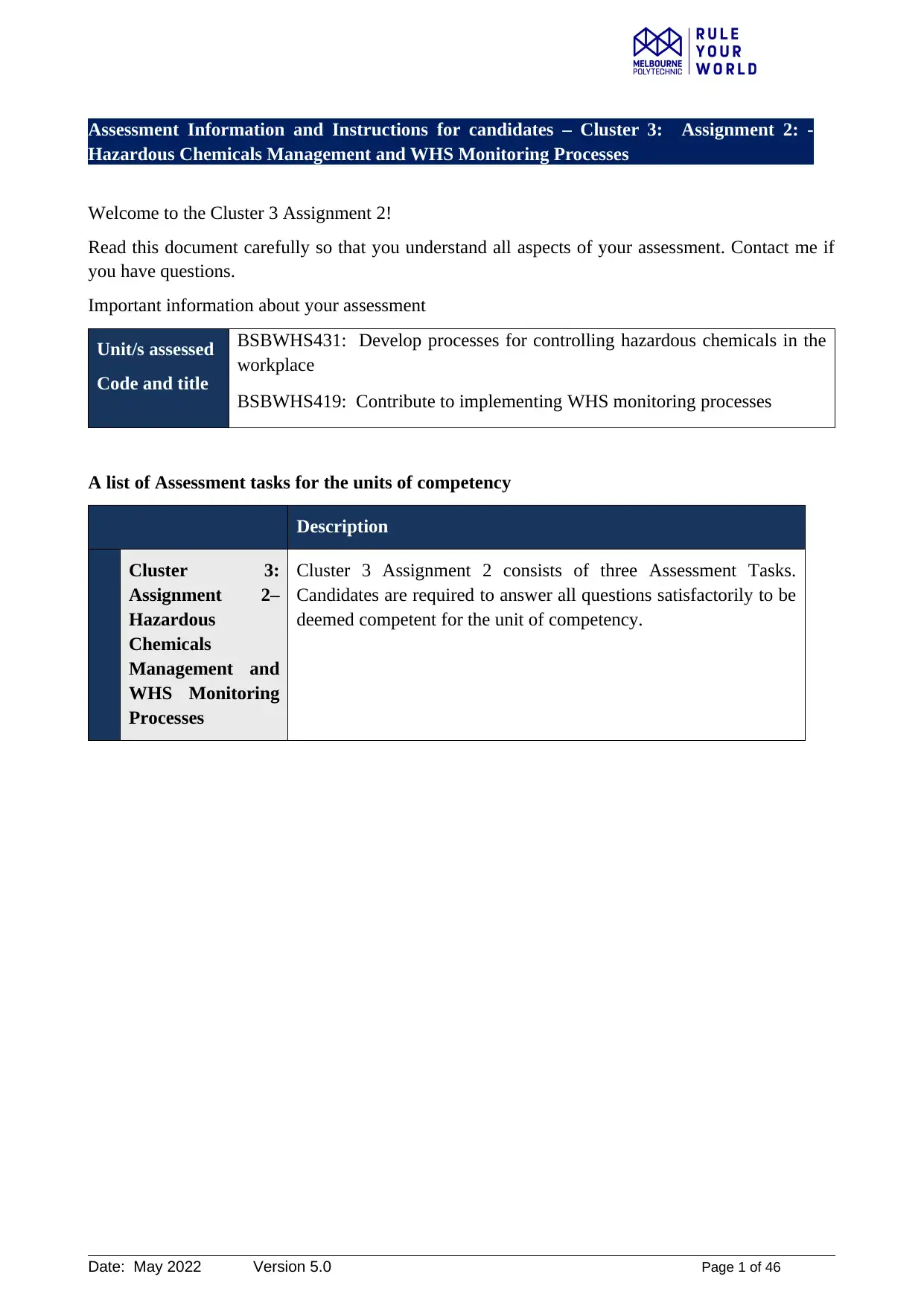
Assessment Information and Instructions for candidates – Cluster 3: Assignment 2: -
Hazardous Chemicals Management and WHS Monitoring Processes
Welcome to the Cluster 3 Assignment 2!
Read this document carefully so that you understand all aspects of your assessment. Contact me if
you have questions.
Important information about your assessment
Unit/s assessed
Code and title
BSBWHS431: Develop processes for controlling hazardous chemicals in the
workplace
BSBWHS419: Contribute to implementing WHS monitoring processes
A list of Assessment tasks for the units of competency
Description
Cluster 3:
Assignment 2–
Hazardous
Chemicals
Management and
WHS Monitoring
Processes
Cluster 3 Assignment 2 consists of three Assessment Tasks.
Candidates are required to answer all questions satisfactorily to be
deemed competent for the unit of competency.
Date: May 2022 Version 5.0 Page 1 of 46
Hazardous Chemicals Management and WHS Monitoring Processes
Welcome to the Cluster 3 Assignment 2!
Read this document carefully so that you understand all aspects of your assessment. Contact me if
you have questions.
Important information about your assessment
Unit/s assessed
Code and title
BSBWHS431: Develop processes for controlling hazardous chemicals in the
workplace
BSBWHS419: Contribute to implementing WHS monitoring processes
A list of Assessment tasks for the units of competency
Description
Cluster 3:
Assignment 2–
Hazardous
Chemicals
Management and
WHS Monitoring
Processes
Cluster 3 Assignment 2 consists of three Assessment Tasks.
Candidates are required to answer all questions satisfactorily to be
deemed competent for the unit of competency.
Date: May 2022 Version 5.0 Page 1 of 46
Paraphrase This Document
Need a fresh take? Get an instant paraphrase of this document with our AI Paraphraser
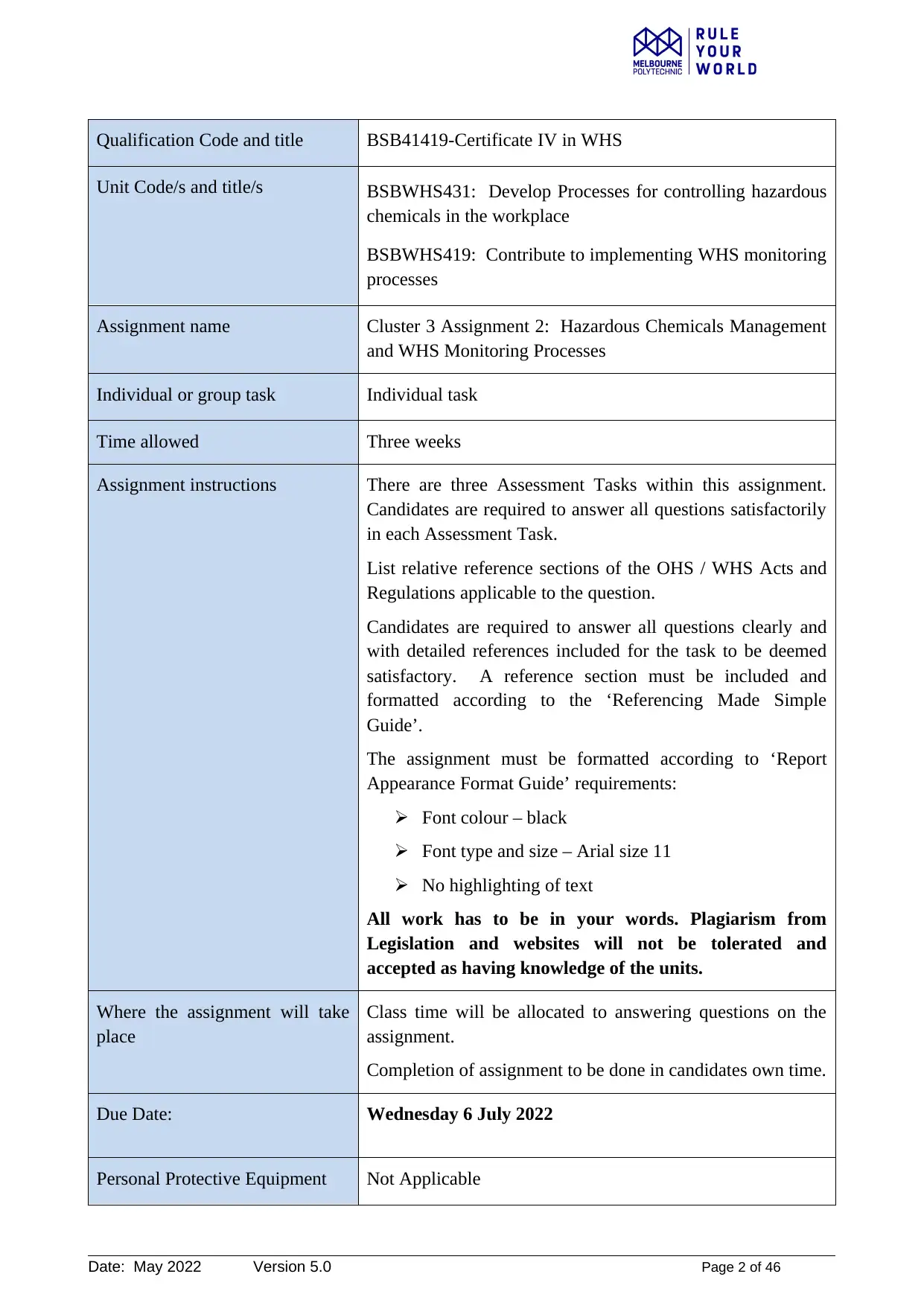
Qualification Code and title BSB41419-Certificate IV in WHS
Unit Code/s and title/s BSBWHS431: Develop Processes for controlling hazardous
chemicals in the workplace
BSBWHS419: Contribute to implementing WHS monitoring
processes
Assignment name Cluster 3 Assignment 2: Hazardous Chemicals Management
and WHS Monitoring Processes
Individual or group task Individual task
Time allowed Three weeks
Assignment instructions There are three Assessment Tasks within this assignment.
Candidates are required to answer all questions satisfactorily
in each Assessment Task.
List relative reference sections of the OHS / WHS Acts and
Regulations applicable to the question.
Candidates are required to answer all questions clearly and
with detailed references included for the task to be deemed
satisfactory. A reference section must be included and
formatted according to the ‘Referencing Made Simple
Guide’.
The assignment must be formatted according to ‘Report
Appearance Format Guide’ requirements:
Font colour – black
Font type and size – Arial size 11
No highlighting of text
All work has to be in your words. Plagiarism from
Legislation and websites will not be tolerated and
accepted as having knowledge of the units.
Where the assignment will take
place
Class time will be allocated to answering questions on the
assignment.
Completion of assignment to be done in candidates own time.
Due Date: Wednesday 6 July 2022
Personal Protective Equipment Not Applicable
Date: May 2022 Version 5.0 Page 2 of 46
Unit Code/s and title/s BSBWHS431: Develop Processes for controlling hazardous
chemicals in the workplace
BSBWHS419: Contribute to implementing WHS monitoring
processes
Assignment name Cluster 3 Assignment 2: Hazardous Chemicals Management
and WHS Monitoring Processes
Individual or group task Individual task
Time allowed Three weeks
Assignment instructions There are three Assessment Tasks within this assignment.
Candidates are required to answer all questions satisfactorily
in each Assessment Task.
List relative reference sections of the OHS / WHS Acts and
Regulations applicable to the question.
Candidates are required to answer all questions clearly and
with detailed references included for the task to be deemed
satisfactory. A reference section must be included and
formatted according to the ‘Referencing Made Simple
Guide’.
The assignment must be formatted according to ‘Report
Appearance Format Guide’ requirements:
Font colour – black
Font type and size – Arial size 11
No highlighting of text
All work has to be in your words. Plagiarism from
Legislation and websites will not be tolerated and
accepted as having knowledge of the units.
Where the assignment will take
place
Class time will be allocated to answering questions on the
assignment.
Completion of assignment to be done in candidates own time.
Due Date: Wednesday 6 July 2022
Personal Protective Equipment Not Applicable
Date: May 2022 Version 5.0 Page 2 of 46
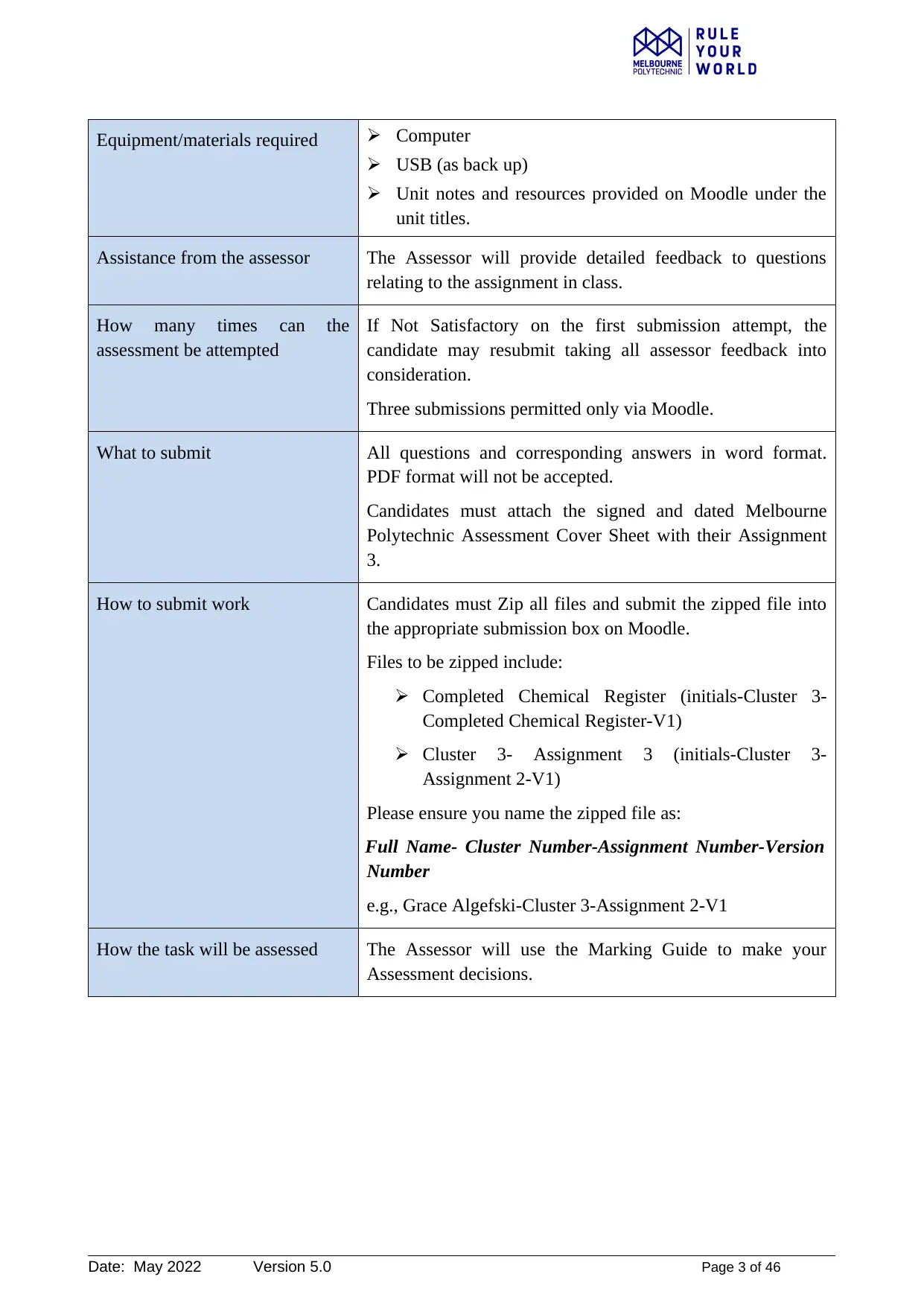
Equipment/materials required Computer
USB (as back up)
Unit notes and resources provided on Moodle under the
unit titles.
Assistance from the assessor The Assessor will provide detailed feedback to questions
relating to the assignment in class.
How many times can the
assessment be attempted
If Not Satisfactory on the first submission attempt, the
candidate may resubmit taking all assessor feedback into
consideration.
Three submissions permitted only via Moodle.
What to submit All questions and corresponding answers in word format.
PDF format will not be accepted.
Candidates must attach the signed and dated Melbourne
Polytechnic Assessment Cover Sheet with their Assignment
3.
How to submit work Candidates must Zip all files and submit the zipped file into
the appropriate submission box on Moodle.
Files to be zipped include:
Completed Chemical Register (initials-Cluster 3-
Completed Chemical Register-V1)
Cluster 3- Assignment 3 (initials-Cluster 3-
Assignment 2-V1)
Please ensure you name the zipped file as:
Full Name- Cluster Number-Assignment Number-Version
Number
e.g., Grace Algefski-Cluster 3-Assignment 2-V1
How the task will be assessed The Assessor will use the Marking Guide to make your
Assessment decisions.
Date: May 2022 Version 5.0 Page 3 of 46
USB (as back up)
Unit notes and resources provided on Moodle under the
unit titles.
Assistance from the assessor The Assessor will provide detailed feedback to questions
relating to the assignment in class.
How many times can the
assessment be attempted
If Not Satisfactory on the first submission attempt, the
candidate may resubmit taking all assessor feedback into
consideration.
Three submissions permitted only via Moodle.
What to submit All questions and corresponding answers in word format.
PDF format will not be accepted.
Candidates must attach the signed and dated Melbourne
Polytechnic Assessment Cover Sheet with their Assignment
3.
How to submit work Candidates must Zip all files and submit the zipped file into
the appropriate submission box on Moodle.
Files to be zipped include:
Completed Chemical Register (initials-Cluster 3-
Completed Chemical Register-V1)
Cluster 3- Assignment 3 (initials-Cluster 3-
Assignment 2-V1)
Please ensure you name the zipped file as:
Full Name- Cluster Number-Assignment Number-Version
Number
e.g., Grace Algefski-Cluster 3-Assignment 2-V1
How the task will be assessed The Assessor will use the Marking Guide to make your
Assessment decisions.
Date: May 2022 Version 5.0 Page 3 of 46
⊘ This is a preview!⊘
Do you want full access?
Subscribe today to unlock all pages.

Trusted by 1+ million students worldwide

Assessment Cover Sheet
Name
Student ID
Phone number
Email
Course code and
name
BSB41419-Certificate IV in WHS
Unit code and name BSBWHS431: Develop Processes for controlling hazardous chemicals
in the workplace
BSBWHS419: Contribute to implementing WHS monitoring
processes
Name of assessment Cluster 3 Assignment 2: Hazardous Chemicals Management and
WHS Monitoring Processes
Due Date 06/07/2022
Teacher name Grace Algefski
Instructions
Declaration: Read, tick and sign below
I declare that the attached assessment I have submitted is my own original work and any
contributions from and references to other authors are clearly acknowledged and noted.
This document has been created for the purpose of this assessment only and has not been
submitted as another form of assessment at Melbourne Polytechnic or any other tertiary
institute.
I have retained a copy of this work for my reference in the event that this application is lost or
damaged.
I give permission for Melbourne Polytechnic to keep, make copies of and communicate my
work for the purpose of investigating plagiarism and/or review by internal and external
assessors.
I understand that plagiarism is the act of using another person’s idea or work and presenting it as
my own. This is a serious offence and I will accept that penalties will be imposed on me should I
breach Melbourne Polytechnic’s plagiarism policy.
Student signature ……………………………………………………Date …… / .….. / …...
Date: May 2022 Version 5.0 Page 4 of 46
Name
Student ID
Phone number
Course code and
name
BSB41419-Certificate IV in WHS
Unit code and name BSBWHS431: Develop Processes for controlling hazardous chemicals
in the workplace
BSBWHS419: Contribute to implementing WHS monitoring
processes
Name of assessment Cluster 3 Assignment 2: Hazardous Chemicals Management and
WHS Monitoring Processes
Due Date 06/07/2022
Teacher name Grace Algefski
Instructions
Declaration: Read, tick and sign below
I declare that the attached assessment I have submitted is my own original work and any
contributions from and references to other authors are clearly acknowledged and noted.
This document has been created for the purpose of this assessment only and has not been
submitted as another form of assessment at Melbourne Polytechnic or any other tertiary
institute.
I have retained a copy of this work for my reference in the event that this application is lost or
damaged.
I give permission for Melbourne Polytechnic to keep, make copies of and communicate my
work for the purpose of investigating plagiarism and/or review by internal and external
assessors.
I understand that plagiarism is the act of using another person’s idea or work and presenting it as
my own. This is a serious offence and I will accept that penalties will be imposed on me should I
breach Melbourne Polytechnic’s plagiarism policy.
Student signature ……………………………………………………Date …… / .….. / …...
Date: May 2022 Version 5.0 Page 4 of 46
Paraphrase This Document
Need a fresh take? Get an instant paraphrase of this document with our AI Paraphraser
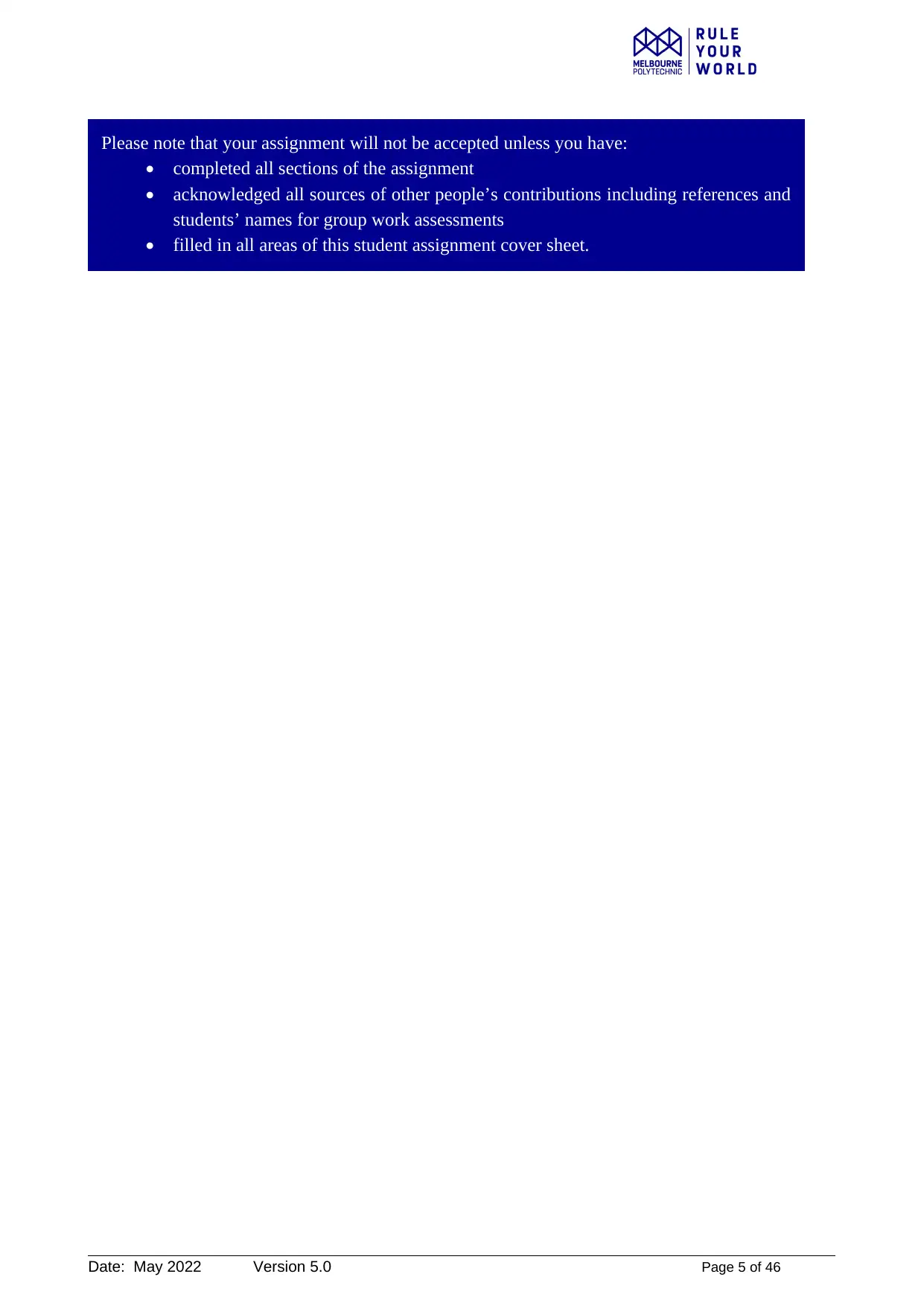
Please note that your assignment will not be accepted unless you have:
• completed all sections of the assignment
• acknowledged all sources of other people’s contributions including references and
students’ names for group work assessments
• filled in all areas of this student assignment cover sheet.
Date: May 2022 Version 5.0 Page 5 of 46
• completed all sections of the assignment
• acknowledged all sources of other people’s contributions including references and
students’ names for group work assessments
• filled in all areas of this student assignment cover sheet.
Date: May 2022 Version 5.0 Page 5 of 46
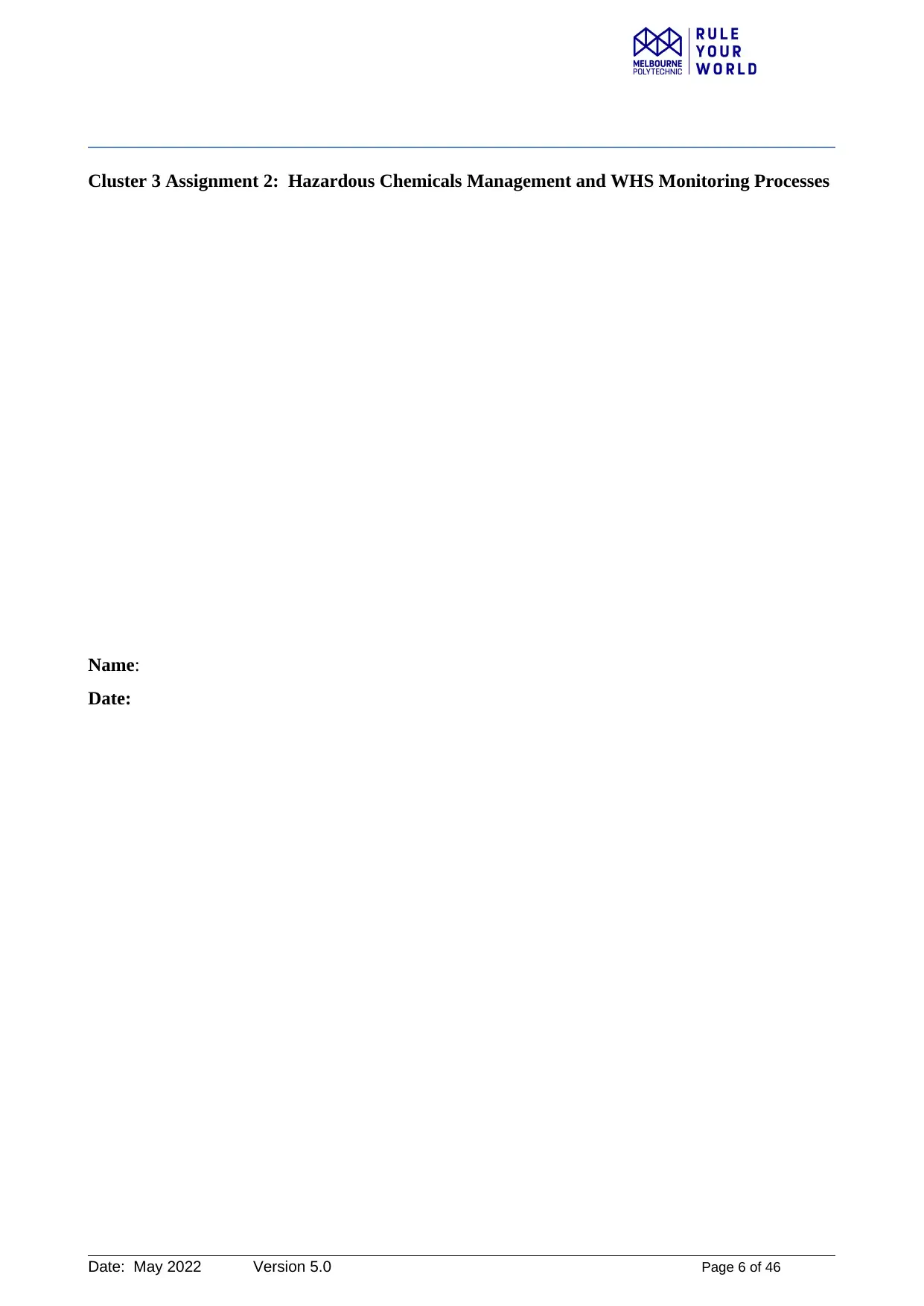
Cluster 3 Assignment 2: Hazardous Chemicals Management and WHS Monitoring Processes
Name:
Date:
Date: May 2022 Version 5.0 Page 6 of 46
Name:
Date:
Date: May 2022 Version 5.0 Page 6 of 46
⊘ This is a preview!⊘
Do you want full access?
Subscribe today to unlock all pages.

Trusted by 1+ million students worldwide
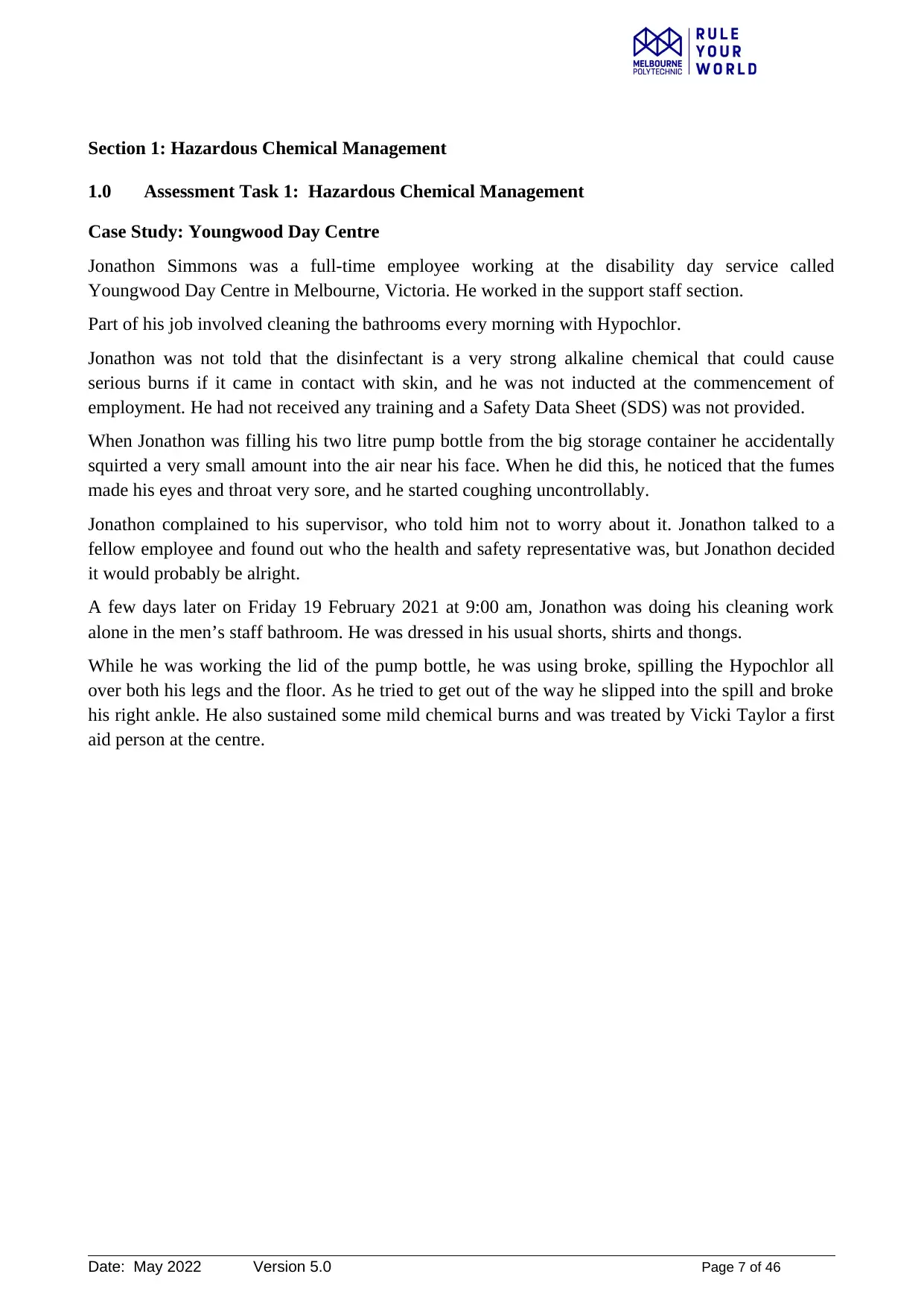
Section 1: Hazardous Chemical Management
1.0 Assessment Task 1: Hazardous Chemical Management
Case Study: Youngwood Day Centre
Jonathon Simmons was a full-time employee working at the disability day service called
Youngwood Day Centre in Melbourne, Victoria. He worked in the support staff section.
Part of his job involved cleaning the bathrooms every morning with Hypochlor.
Jonathon was not told that the disinfectant is a very strong alkaline chemical that could cause
serious burns if it came in contact with skin, and he was not inducted at the commencement of
employment. He had not received any training and a Safety Data Sheet (SDS) was not provided.
When Jonathon was filling his two litre pump bottle from the big storage container he accidentally
squirted a very small amount into the air near his face. When he did this, he noticed that the fumes
made his eyes and throat very sore, and he started coughing uncontrollably.
Jonathon complained to his supervisor, who told him not to worry about it. Jonathon talked to a
fellow employee and found out who the health and safety representative was, but Jonathon decided
it would probably be alright.
A few days later on Friday 19 February 2021 at 9:00 am, Jonathon was doing his cleaning work
alone in the men’s staff bathroom. He was dressed in his usual shorts, shirts and thongs.
While he was working the lid of the pump bottle, he was using broke, spilling the Hypochlor all
over both his legs and the floor. As he tried to get out of the way he slipped into the spill and broke
his right ankle. He also sustained some mild chemical burns and was treated by Vicki Taylor a first
aid person at the centre.
Date: May 2022 Version 5.0 Page 7 of 46
1.0 Assessment Task 1: Hazardous Chemical Management
Case Study: Youngwood Day Centre
Jonathon Simmons was a full-time employee working at the disability day service called
Youngwood Day Centre in Melbourne, Victoria. He worked in the support staff section.
Part of his job involved cleaning the bathrooms every morning with Hypochlor.
Jonathon was not told that the disinfectant is a very strong alkaline chemical that could cause
serious burns if it came in contact with skin, and he was not inducted at the commencement of
employment. He had not received any training and a Safety Data Sheet (SDS) was not provided.
When Jonathon was filling his two litre pump bottle from the big storage container he accidentally
squirted a very small amount into the air near his face. When he did this, he noticed that the fumes
made his eyes and throat very sore, and he started coughing uncontrollably.
Jonathon complained to his supervisor, who told him not to worry about it. Jonathon talked to a
fellow employee and found out who the health and safety representative was, but Jonathon decided
it would probably be alright.
A few days later on Friday 19 February 2021 at 9:00 am, Jonathon was doing his cleaning work
alone in the men’s staff bathroom. He was dressed in his usual shorts, shirts and thongs.
While he was working the lid of the pump bottle, he was using broke, spilling the Hypochlor all
over both his legs and the floor. As he tried to get out of the way he slipped into the spill and broke
his right ankle. He also sustained some mild chemical burns and was treated by Vicki Taylor a first
aid person at the centre.
Date: May 2022 Version 5.0 Page 7 of 46
Paraphrase This Document
Need a fresh take? Get an instant paraphrase of this document with our AI Paraphraser

General Questions:
1.1 Identify the legislation relating to the using, handling, generating and storing of hazardous
chemicals and dangerous goods in the workplace?
ANSWER: There are some legislation which are associated with the handling, storing and generating of
hazardous chemical and dangerous goods in the wok place. It includes Work Health and Safety Regulation
2011, The Dangerous Good Act and associated Regulation, Control of substances of Health Regulation 2002
(COSHH) (Kloss, 2020)
1.2 How is the legislation applied to using, handling, generating and storing hazardous chemicals
in the workplace?
ANSWER: There are 5 step for applying legislation on hazardous chemical in the organization.
Collect the data of the substances which are use at workplace.
Evaluation of risk which are associated with health.
Select suitable control measures to reduce the health risks.
Record the collecting data and apply control measures
Supervise the performance and apply the legislation on the hazardous chemicals.(Kish,
2018).
1.3 How can you identify hazardous chemicals and tasks involving their use in the workplace?
ANSWER: To identification of the hazardous chemicals, there is require to check the product's
container label and check the safety data sheet which is provided by the supplier. If the product is
classified under the Work Health and Safety Act 2011 and in safety data sheet, then it is called as
hazardous chemical (Newaz, and et. al., 2021).
1.4 What is a safety data sheet and what information is on a safety data sheet?
ANSWER: Safety data sheet is a document that provide the information about the health and
safety. The document is including information about products, substances and chemicals that
are classified as the hazardous substances or dangerous goods. The safety data sheet includes
the information about the properties of each chemical which are associated with physical
health and environment health hazards. It is also including protective measure and safety
precautions for handling, storing and transporting the chemical (Jatana, and et. al., 2019).
1.5 What hazardous substances have mandatory monitoring requirements?
ANSWER: There are some flammable, oxidizing, explosives, gas under pressure, toxic, serious
health hazards, corrosive and environmental hazards. Hazardous substances include acids,
heavy metals including mercury, lead, cadmium, aluminium, disinfectant, caustic substances,
pesticides and petroleum products (You, and et. al., 2019).
Date: May 2022 Version 5.0 Page 8 of 46
1.1 Identify the legislation relating to the using, handling, generating and storing of hazardous
chemicals and dangerous goods in the workplace?
ANSWER: There are some legislation which are associated with the handling, storing and generating of
hazardous chemical and dangerous goods in the wok place. It includes Work Health and Safety Regulation
2011, The Dangerous Good Act and associated Regulation, Control of substances of Health Regulation 2002
(COSHH) (Kloss, 2020)
1.2 How is the legislation applied to using, handling, generating and storing hazardous chemicals
in the workplace?
ANSWER: There are 5 step for applying legislation on hazardous chemical in the organization.
Collect the data of the substances which are use at workplace.
Evaluation of risk which are associated with health.
Select suitable control measures to reduce the health risks.
Record the collecting data and apply control measures
Supervise the performance and apply the legislation on the hazardous chemicals.(Kish,
2018).
1.3 How can you identify hazardous chemicals and tasks involving their use in the workplace?
ANSWER: To identification of the hazardous chemicals, there is require to check the product's
container label and check the safety data sheet which is provided by the supplier. If the product is
classified under the Work Health and Safety Act 2011 and in safety data sheet, then it is called as
hazardous chemical (Newaz, and et. al., 2021).
1.4 What is a safety data sheet and what information is on a safety data sheet?
ANSWER: Safety data sheet is a document that provide the information about the health and
safety. The document is including information about products, substances and chemicals that
are classified as the hazardous substances or dangerous goods. The safety data sheet includes
the information about the properties of each chemical which are associated with physical
health and environment health hazards. It is also including protective measure and safety
precautions for handling, storing and transporting the chemical (Jatana, and et. al., 2019).
1.5 What hazardous substances have mandatory monitoring requirements?
ANSWER: There are some flammable, oxidizing, explosives, gas under pressure, toxic, serious
health hazards, corrosive and environmental hazards. Hazardous substances include acids,
heavy metals including mercury, lead, cadmium, aluminium, disinfectant, caustic substances,
pesticides and petroleum products (You, and et. al., 2019).
Date: May 2022 Version 5.0 Page 8 of 46
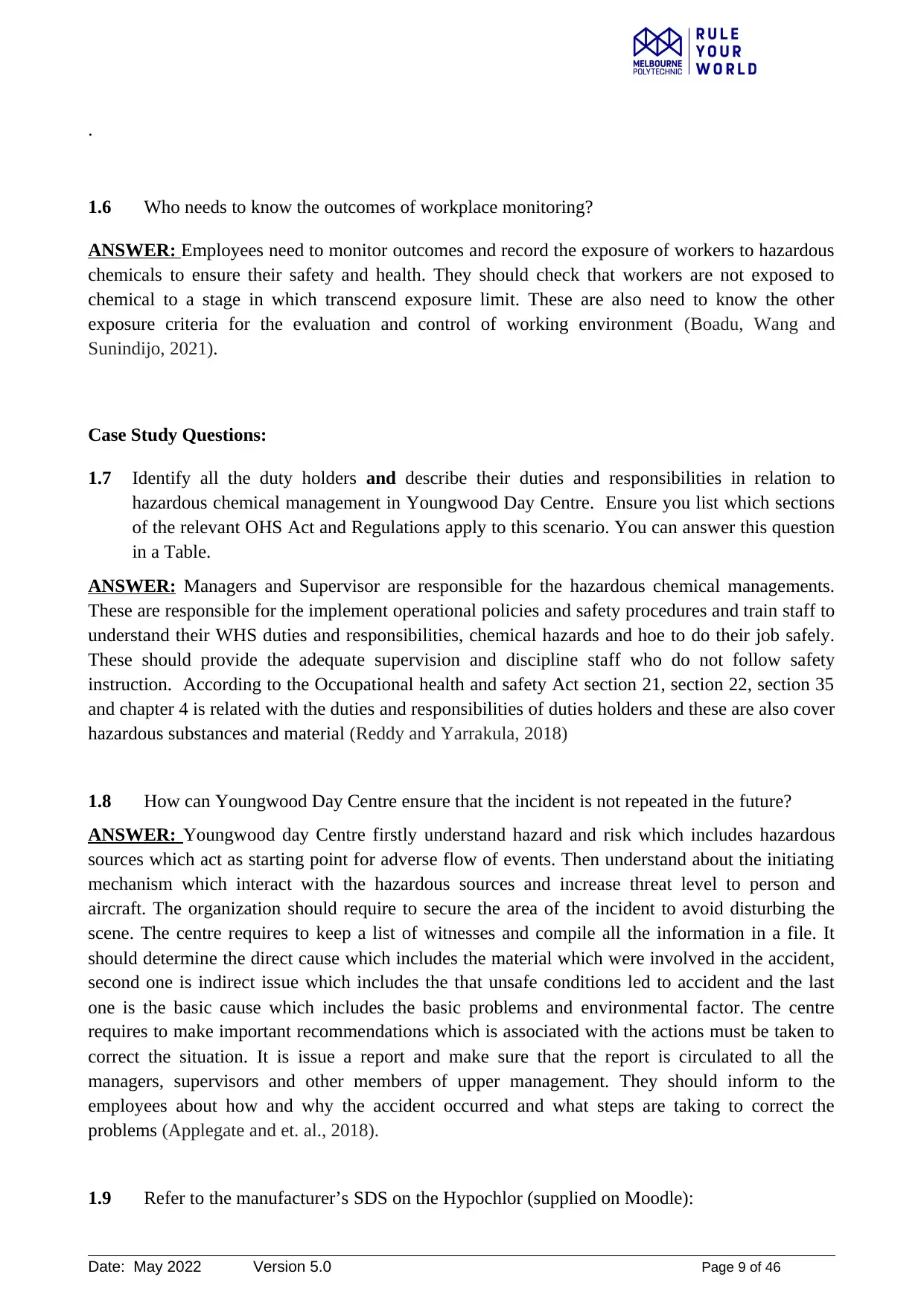
.
1.6 Who needs to know the outcomes of workplace monitoring?
ANSWER: Employees need to monitor outcomes and record the exposure of workers to hazardous
chemicals to ensure their safety and health. They should check that workers are not exposed to
chemical to a stage in which transcend exposure limit. These are also need to know the other
exposure criteria for the evaluation and control of working environment (Boadu, Wang and
Sunindijo, 2021).
Case Study Questions:
1.7 Identify all the duty holders and describe their duties and responsibilities in relation to
hazardous chemical management in Youngwood Day Centre. Ensure you list which sections
of the relevant OHS Act and Regulations apply to this scenario. You can answer this question
in a Table.
ANSWER: Managers and Supervisor are responsible for the hazardous chemical managements.
These are responsible for the implement operational policies and safety procedures and train staff to
understand their WHS duties and responsibilities, chemical hazards and hoe to do their job safely.
These should provide the adequate supervision and discipline staff who do not follow safety
instruction. According to the Occupational health and safety Act section 21, section 22, section 35
and chapter 4 is related with the duties and responsibilities of duties holders and these are also cover
hazardous substances and material (Reddy and Yarrakula, 2018)
1.8 How can Youngwood Day Centre ensure that the incident is not repeated in the future?
ANSWER: Youngwood day Centre firstly understand hazard and risk which includes hazardous
sources which act as starting point for adverse flow of events. Then understand about the initiating
mechanism which interact with the hazardous sources and increase threat level to person and
aircraft. The organization should require to secure the area of the incident to avoid disturbing the
scene. The centre requires to keep a list of witnesses and compile all the information in a file. It
should determine the direct cause which includes the material which were involved in the accident,
second one is indirect issue which includes the that unsafe conditions led to accident and the last
one is the basic cause which includes the basic problems and environmental factor. The centre
requires to make important recommendations which is associated with the actions must be taken to
correct the situation. It is issue a report and make sure that the report is circulated to all the
managers, supervisors and other members of upper management. They should inform to the
employees about how and why the accident occurred and what steps are taking to correct the
problems (Applegate and et. al., 2018).
1.9 Refer to the manufacturer’s SDS on the Hypochlor (supplied on Moodle):
Date: May 2022 Version 5.0 Page 9 of 46
1.6 Who needs to know the outcomes of workplace monitoring?
ANSWER: Employees need to monitor outcomes and record the exposure of workers to hazardous
chemicals to ensure their safety and health. They should check that workers are not exposed to
chemical to a stage in which transcend exposure limit. These are also need to know the other
exposure criteria for the evaluation and control of working environment (Boadu, Wang and
Sunindijo, 2021).
Case Study Questions:
1.7 Identify all the duty holders and describe their duties and responsibilities in relation to
hazardous chemical management in Youngwood Day Centre. Ensure you list which sections
of the relevant OHS Act and Regulations apply to this scenario. You can answer this question
in a Table.
ANSWER: Managers and Supervisor are responsible for the hazardous chemical managements.
These are responsible for the implement operational policies and safety procedures and train staff to
understand their WHS duties and responsibilities, chemical hazards and hoe to do their job safely.
These should provide the adequate supervision and discipline staff who do not follow safety
instruction. According to the Occupational health and safety Act section 21, section 22, section 35
and chapter 4 is related with the duties and responsibilities of duties holders and these are also cover
hazardous substances and material (Reddy and Yarrakula, 2018)
1.8 How can Youngwood Day Centre ensure that the incident is not repeated in the future?
ANSWER: Youngwood day Centre firstly understand hazard and risk which includes hazardous
sources which act as starting point for adverse flow of events. Then understand about the initiating
mechanism which interact with the hazardous sources and increase threat level to person and
aircraft. The organization should require to secure the area of the incident to avoid disturbing the
scene. The centre requires to keep a list of witnesses and compile all the information in a file. It
should determine the direct cause which includes the material which were involved in the accident,
second one is indirect issue which includes the that unsafe conditions led to accident and the last
one is the basic cause which includes the basic problems and environmental factor. The centre
requires to make important recommendations which is associated with the actions must be taken to
correct the situation. It is issue a report and make sure that the report is circulated to all the
managers, supervisors and other members of upper management. They should inform to the
employees about how and why the accident occurred and what steps are taking to correct the
problems (Applegate and et. al., 2018).
1.9 Refer to the manufacturer’s SDS on the Hypochlor (supplied on Moodle):
Date: May 2022 Version 5.0 Page 9 of 46
⊘ This is a preview!⊘
Do you want full access?
Subscribe today to unlock all pages.

Trusted by 1+ million students worldwide
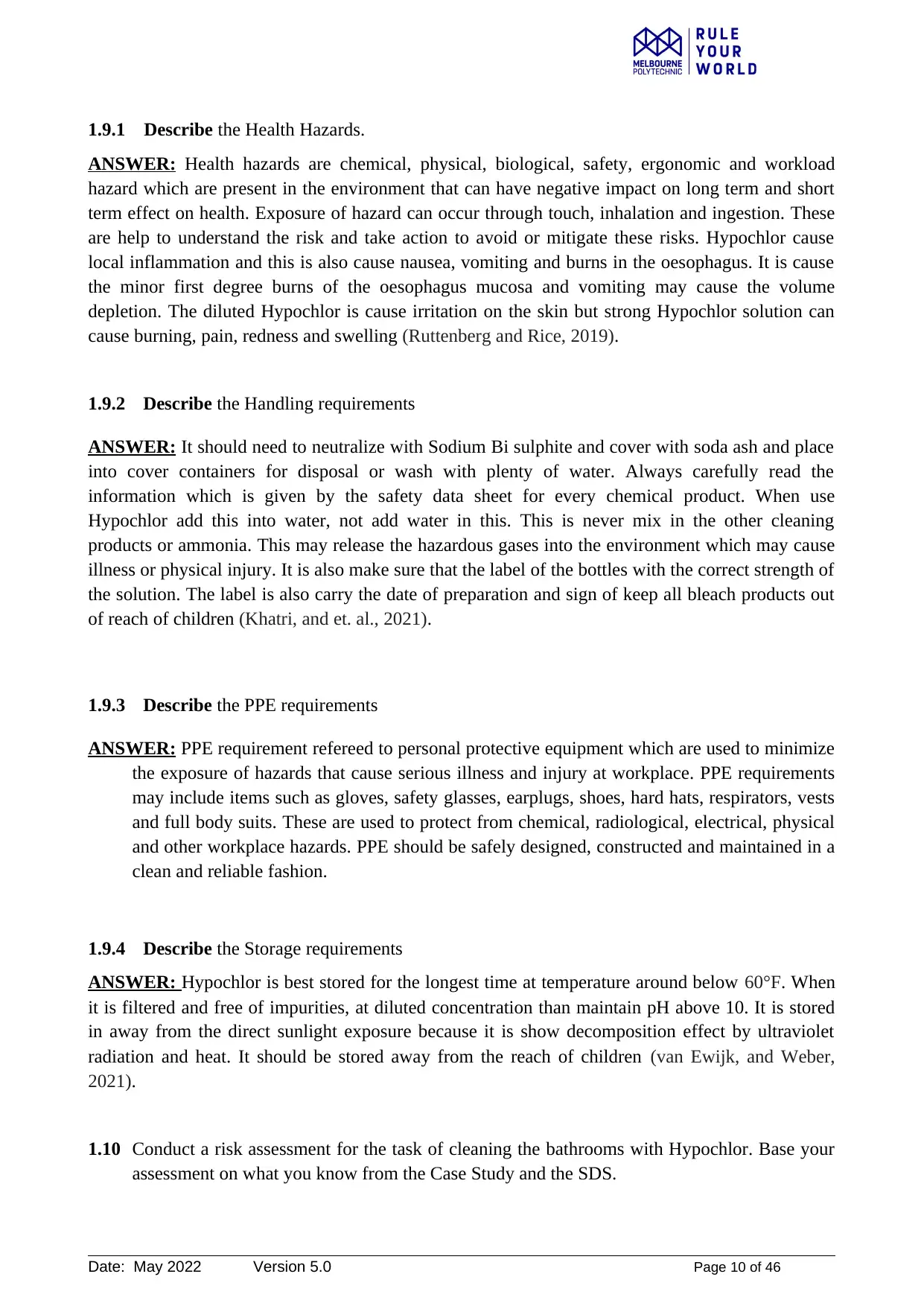
1.9.1 Describe the Health Hazards.
ANSWER: Health hazards are chemical, physical, biological, safety, ergonomic and workload
hazard which are present in the environment that can have negative impact on long term and short
term effect on health. Exposure of hazard can occur through touch, inhalation and ingestion. These
are help to understand the risk and take action to avoid or mitigate these risks. Hypochlor cause
local inflammation and this is also cause nausea, vomiting and burns in the oesophagus. It is cause
the minor first degree burns of the oesophagus mucosa and vomiting may cause the volume
depletion. The diluted Hypochlor is cause irritation on the skin but strong Hypochlor solution can
cause burning, pain, redness and swelling (Ruttenberg and Rice, 2019).
1.9.2 Describe the Handling requirements
ANSWER: It should need to neutralize with Sodium Bi sulphite and cover with soda ash and place
into cover containers for disposal or wash with plenty of water. Always carefully read the
information which is given by the safety data sheet for every chemical product. When use
Hypochlor add this into water, not add water in this. This is never mix in the other cleaning
products or ammonia. This may release the hazardous gases into the environment which may cause
illness or physical injury. It is also make sure that the label of the bottles with the correct strength of
the solution. The label is also carry the date of preparation and sign of keep all bleach products out
of reach of children (Khatri, and et. al., 2021).
1.9.3 Describe the PPE requirements
ANSWER: PPE requirement refereed to personal protective equipment which are used to minimize
the exposure of hazards that cause serious illness and injury at workplace. PPE requirements
may include items such as gloves, safety glasses, earplugs, shoes, hard hats, respirators, vests
and full body suits. These are used to protect from chemical, radiological, electrical, physical
and other workplace hazards. PPE should be safely designed, constructed and maintained in a
clean and reliable fashion.
1.9.4 Describe the Storage requirements
ANSWER: Hypochlor is best stored for the longest time at temperature around below 60°F. When
it is filtered and free of impurities, at diluted concentration than maintain pH above 10. It is stored
in away from the direct sunlight exposure because it is show decomposition effect by ultraviolet
radiation and heat. It should be stored away from the reach of children (van Ewijk, and Weber,
2021).
1.10 Conduct a risk assessment for the task of cleaning the bathrooms with Hypochlor. Base your
assessment on what you know from the Case Study and the SDS.
Date: May 2022 Version 5.0 Page 10 of 46
ANSWER: Health hazards are chemical, physical, biological, safety, ergonomic and workload
hazard which are present in the environment that can have negative impact on long term and short
term effect on health. Exposure of hazard can occur through touch, inhalation and ingestion. These
are help to understand the risk and take action to avoid or mitigate these risks. Hypochlor cause
local inflammation and this is also cause nausea, vomiting and burns in the oesophagus. It is cause
the minor first degree burns of the oesophagus mucosa and vomiting may cause the volume
depletion. The diluted Hypochlor is cause irritation on the skin but strong Hypochlor solution can
cause burning, pain, redness and swelling (Ruttenberg and Rice, 2019).
1.9.2 Describe the Handling requirements
ANSWER: It should need to neutralize with Sodium Bi sulphite and cover with soda ash and place
into cover containers for disposal or wash with plenty of water. Always carefully read the
information which is given by the safety data sheet for every chemical product. When use
Hypochlor add this into water, not add water in this. This is never mix in the other cleaning
products or ammonia. This may release the hazardous gases into the environment which may cause
illness or physical injury. It is also make sure that the label of the bottles with the correct strength of
the solution. The label is also carry the date of preparation and sign of keep all bleach products out
of reach of children (Khatri, and et. al., 2021).
1.9.3 Describe the PPE requirements
ANSWER: PPE requirement refereed to personal protective equipment which are used to minimize
the exposure of hazards that cause serious illness and injury at workplace. PPE requirements
may include items such as gloves, safety glasses, earplugs, shoes, hard hats, respirators, vests
and full body suits. These are used to protect from chemical, radiological, electrical, physical
and other workplace hazards. PPE should be safely designed, constructed and maintained in a
clean and reliable fashion.
1.9.4 Describe the Storage requirements
ANSWER: Hypochlor is best stored for the longest time at temperature around below 60°F. When
it is filtered and free of impurities, at diluted concentration than maintain pH above 10. It is stored
in away from the direct sunlight exposure because it is show decomposition effect by ultraviolet
radiation and heat. It should be stored away from the reach of children (van Ewijk, and Weber,
2021).
1.10 Conduct a risk assessment for the task of cleaning the bathrooms with Hypochlor. Base your
assessment on what you know from the Case Study and the SDS.
Date: May 2022 Version 5.0 Page 10 of 46
Paraphrase This Document
Need a fresh take? Get an instant paraphrase of this document with our AI Paraphraser
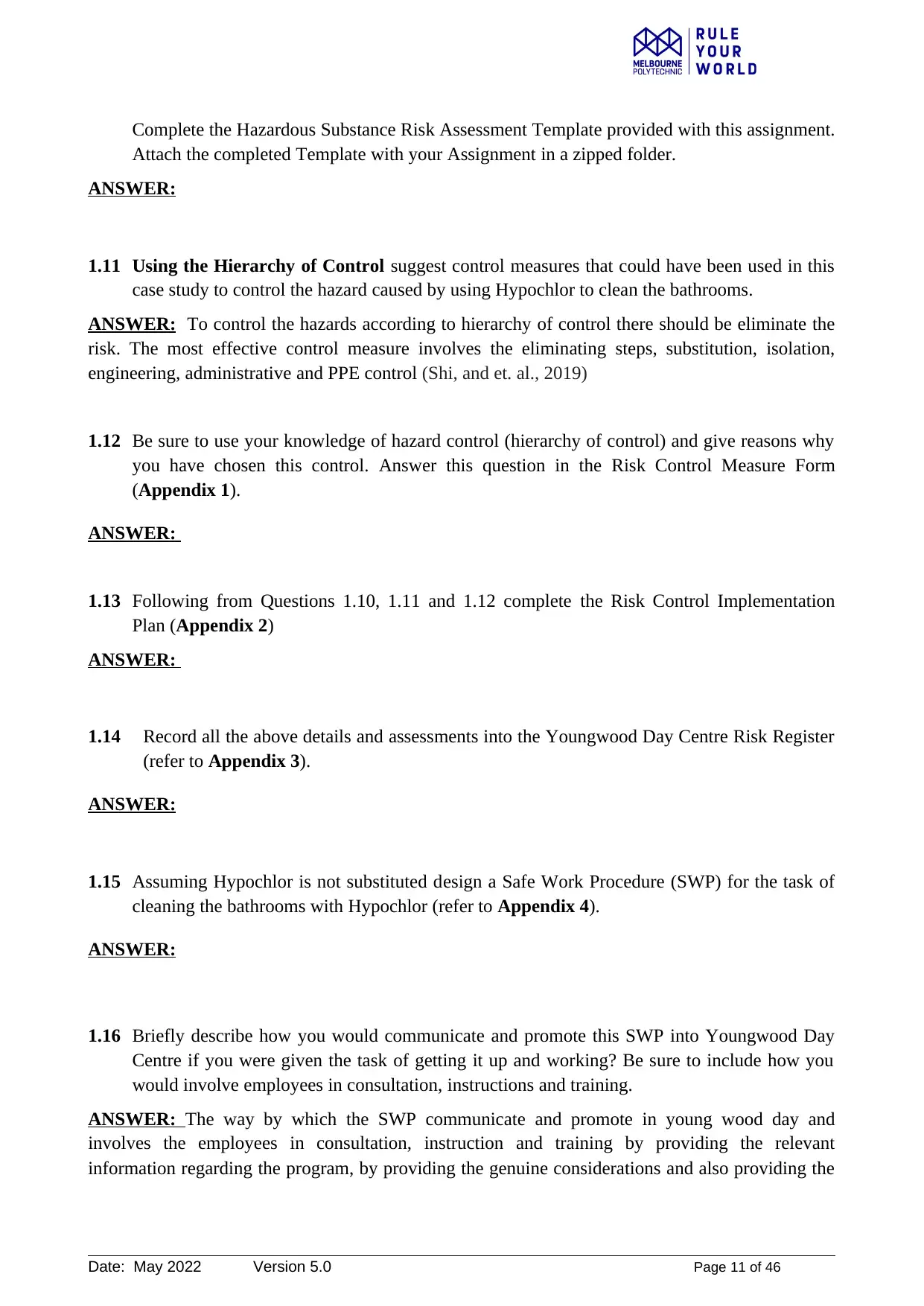
Complete the Hazardous Substance Risk Assessment Template provided with this assignment.
Attach the completed Template with your Assignment in a zipped folder.
ANSWER:
1.11 Using the Hierarchy of Control suggest control measures that could have been used in this
case study to control the hazard caused by using Hypochlor to clean the bathrooms.
ANSWER: To control the hazards according to hierarchy of control there should be eliminate the
risk. The most effective control measure involves the eliminating steps, substitution, isolation,
engineering, administrative and PPE control (Shi, and et. al., 2019)
1.12 Be sure to use your knowledge of hazard control (hierarchy of control) and give reasons why
you have chosen this control. Answer this question in the Risk Control Measure Form
(Appendix 1).
ANSWER:
1.13 Following from Questions 1.10, 1.11 and 1.12 complete the Risk Control Implementation
Plan (Appendix 2)
ANSWER:
1.14 Record all the above details and assessments into the Youngwood Day Centre Risk Register
(refer to Appendix 3).
ANSWER:
1.15 Assuming Hypochlor is not substituted design a Safe Work Procedure (SWP) for the task of
cleaning the bathrooms with Hypochlor (refer to Appendix 4).
ANSWER:
1.16 Briefly describe how you would communicate and promote this SWP into Youngwood Day
Centre if you were given the task of getting it up and working? Be sure to include how you
would involve employees in consultation, instructions and training.
ANSWER: The way by which the SWP communicate and promote in young wood day and
involves the employees in consultation, instruction and training by providing the relevant
information regarding the program, by providing the genuine considerations and also providing the
Date: May 2022 Version 5.0 Page 11 of 46
Attach the completed Template with your Assignment in a zipped folder.
ANSWER:
1.11 Using the Hierarchy of Control suggest control measures that could have been used in this
case study to control the hazard caused by using Hypochlor to clean the bathrooms.
ANSWER: To control the hazards according to hierarchy of control there should be eliminate the
risk. The most effective control measure involves the eliminating steps, substitution, isolation,
engineering, administrative and PPE control (Shi, and et. al., 2019)
1.12 Be sure to use your knowledge of hazard control (hierarchy of control) and give reasons why
you have chosen this control. Answer this question in the Risk Control Measure Form
(Appendix 1).
ANSWER:
1.13 Following from Questions 1.10, 1.11 and 1.12 complete the Risk Control Implementation
Plan (Appendix 2)
ANSWER:
1.14 Record all the above details and assessments into the Youngwood Day Centre Risk Register
(refer to Appendix 3).
ANSWER:
1.15 Assuming Hypochlor is not substituted design a Safe Work Procedure (SWP) for the task of
cleaning the bathrooms with Hypochlor (refer to Appendix 4).
ANSWER:
1.16 Briefly describe how you would communicate and promote this SWP into Youngwood Day
Centre if you were given the task of getting it up and working? Be sure to include how you
would involve employees in consultation, instructions and training.
ANSWER: The way by which the SWP communicate and promote in young wood day and
involves the employees in consultation, instruction and training by providing the relevant
information regarding the program, by providing the genuine considerations and also providing the
Date: May 2022 Version 5.0 Page 11 of 46
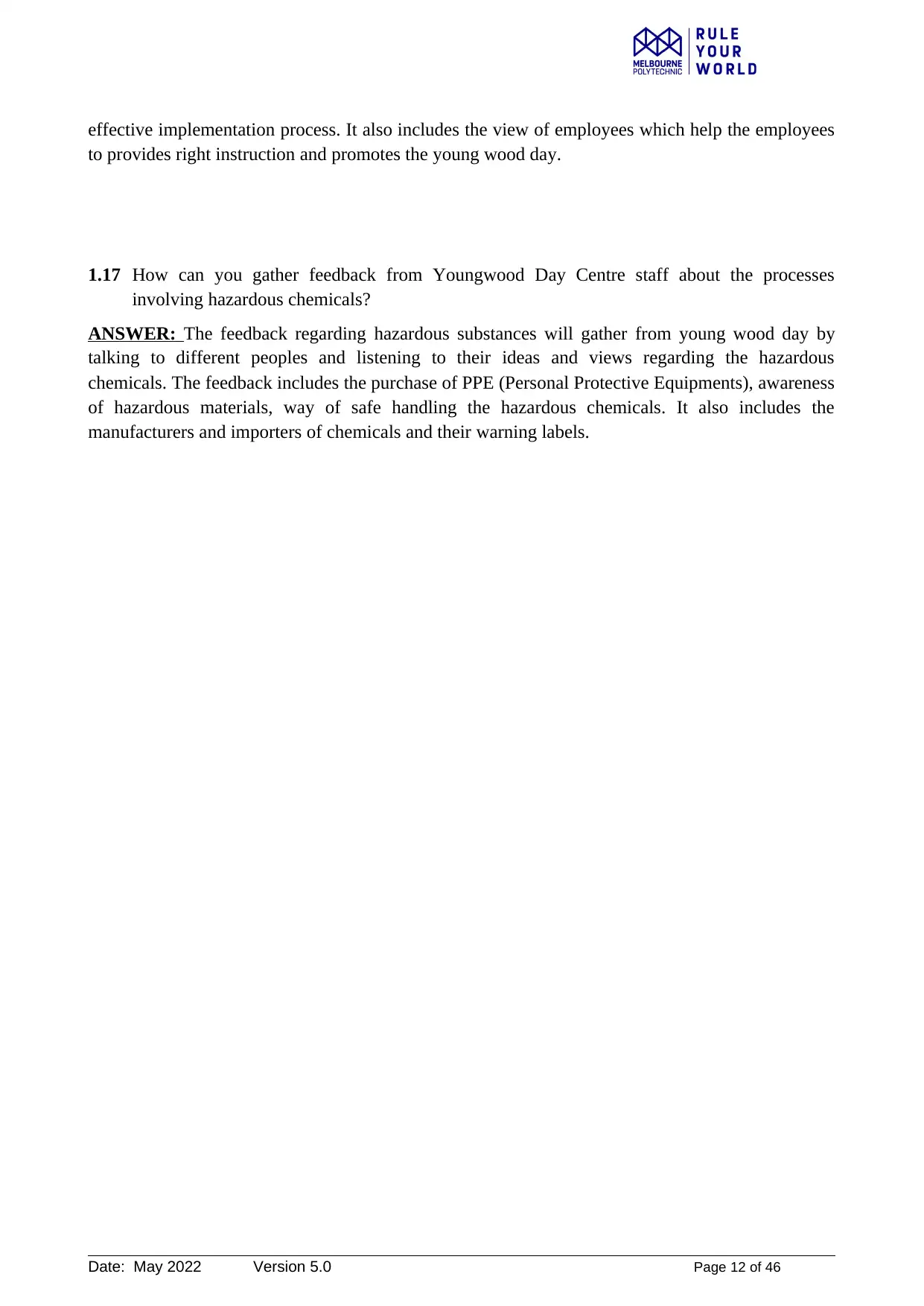
effective implementation process. It also includes the view of employees which help the employees
to provides right instruction and promotes the young wood day.
1.17 How can you gather feedback from Youngwood Day Centre staff about the processes
involving hazardous chemicals?
ANSWER: The feedback regarding hazardous substances will gather from young wood day by
talking to different peoples and listening to their ideas and views regarding the hazardous
chemicals. The feedback includes the purchase of PPE (Personal Protective Equipments), awareness
of hazardous materials, way of safe handling the hazardous chemicals. It also includes the
manufacturers and importers of chemicals and their warning labels.
Date: May 2022 Version 5.0 Page 12 of 46
to provides right instruction and promotes the young wood day.
1.17 How can you gather feedback from Youngwood Day Centre staff about the processes
involving hazardous chemicals?
ANSWER: The feedback regarding hazardous substances will gather from young wood day by
talking to different peoples and listening to their ideas and views regarding the hazardous
chemicals. The feedback includes the purchase of PPE (Personal Protective Equipments), awareness
of hazardous materials, way of safe handling the hazardous chemicals. It also includes the
manufacturers and importers of chemicals and their warning labels.
Date: May 2022 Version 5.0 Page 12 of 46
⊘ This is a preview!⊘
Do you want full access?
Subscribe today to unlock all pages.

Trusted by 1+ million students worldwide
1 out of 46
Related Documents
Your All-in-One AI-Powered Toolkit for Academic Success.
+13062052269
info@desklib.com
Available 24*7 on WhatsApp / Email
![[object Object]](/_next/static/media/star-bottom.7253800d.svg)
Unlock your academic potential
Copyright © 2020–2025 A2Z Services. All Rights Reserved. Developed and managed by ZUCOL.





